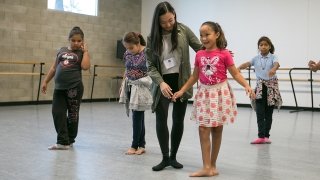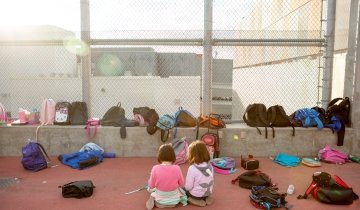It is early afternoon at Orange County School of the Arts, and academic classes are in full swing. Teams of math students puzzle over equations as they compute the distance of a race. In a literature and composition class, an eighth-grade writer channels Grace O’Malley, a Renaissance pirate queen.
Come 2:15 p.m., the campus flips a switch. Gazing into mirrors, young actors apply cringe-inducing scars with special-effects makeup. In a Michelin-worthy commercial kitchen, budding chefs learn about molecular gastronomy while concocting raspberry foam. Juniors and seniors practicing Mexican folklórico techniques tap across the vibrating floor of a dance studio.
At a time when many urban public schools struggle to keep students engaged in academics and to fund arts programs, this public charter school in downtown Santa Ana, Calif., has devised a winning formula. The school serves not only its students but also the greater community with summer and after-school art programs, many of them free.
Known as OCSA (pronounced OH-sha), the school is also seeking to spread its successful combination of arts, academics and collaboration to satellites. In 2017, it opened the California School of the Arts–San Gabriel Valley in Duarte, 40 miles north, in partnership with the Duarte Unified School District. CSArts–SGV is also a public charter school.
“We’re not growing for the sake of growing,” says Ralph Opacic EdD ’94, OCSA’s founder and executive director. “The motivation behind opening additional schools is that we truly believe the OCSA experience is life-changing.”
It has certainly upended precedent: As recent teachers’-strike headlines attest, the relationship between traditional public schools and public charter schools can be fraught. But OCSA has managed to walk the line without making enemies. When it collaborated with Santa Ana in 2000, the local district was facing severe crowding. The addition of a charter school helped to ease the enrollment burden. With students coming from so many communities, no one school or district has faced undue hardship.
It helps that teachers at both OCSA and CSArts–SGV are members of the California Teachers Association, a statewide union.
The successful partnership demonstrates the possibilities when charter schools and traditional public school districts join forces for the betterment of all, says Abbe Levine ’05, dean of arts at the Duarte campus, formerly Northview Intermediate School.
Both CHARTER schools cater to students in grades 7 through 12 with talents in performing, visual, literary and other arts who are willing to put in a longer-than-usual school day.
OCSA students, who participate in an audition/interview placement activity as part of their application for admittance, flock to the campus from 120 cities across multiple counties, as distant as Temecula, Lake Arrowhead and Redondo Beach; 200 commute by train. Each year, the school gets about 3,000 applications for 400 openings.
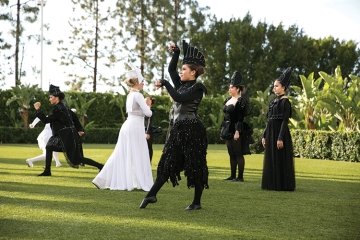
OCSA has 2,200 students and nine buildings. Only one structure—the dance, music and science center—was built from the ground up. The others include creatively renovated former bank buildings and a onetime Christian Science church turned Michael F. Harrah Symphony Hall.
Now in its 32nd year, OCSA puts on about 200 performances annually, many in Symphony Hall or Margaret A. Webb Theatre (where an old bank vault serves as a lounge). The U.S. Department of Education and the National Endowment for the Arts have recognized the school as a model arts-education program.
“Over and over again, I’ve heard from students that, at best, they felt invisible at other schools,” Opacic says. “In this setting, they feel safe to be themselves.”
Jason Cohen, 17, a junior in the instrumental music conservatory who drives 45 minutes from his home in Aliso Viejo, credits OCSA with sparking his interest in a career in entertainment. He has played trumpet since fifth grade, when he attended a traditional public school in Orange County where he endured bullying. After trying home-schooling and public middle school (“I ate lunch by myself every day”), he followed his older sister to OCSA.
“I enjoy it so much,” says Cohen, who takes audio classes and, on the side, serves as executive producer of clever videos for the in-house Watch What Happens OCSA (available on YouTube). “I might be in the instrumental music conservatory, but teachers haven’t stopped me from going out to explore.”
Robust fundraising is key to the success of both OCSA and CSArts–SGV. As public charter schools, they receive funding from the state, but benefactors and education organizations provide financial support that would be the envy of many elite private schools. It also doesn’t hurt that famed OCSA alum Matthew Morrison (1997), who starred as the choir director in the musical series Glee, routinely touts the school.
Both schools ask for a voluntary tax-deductible donation from each family, but regardless of a family’s ability or willingness to give, the schools are committed to providing the same quality educational experience to all.
“In the same year that OCSA was created, we launched the Orange County School of the Arts Foundation,” says Opacic. “Its mission is to raise funds so that there are no barriers for students at OCSA—and now CSArts–SGV—due to families’ financial constraints.
“We created the Artist Scholar Sponsorship Program, which annually raises money specifically for this cause,” he adds. “This past year, the foundation raised over $500,000 to support families who had a financial need.”
OCSA has an operating budget of about $30 million, nearly $10 million of which is raised from parents and donors.
In Duarte, the budget is about $10 million from the state, with $2.5 million raised from parents and donors through the California School of the Arts Foundation, a 501(c)(3) organization modeled on the OCSA Foundation.
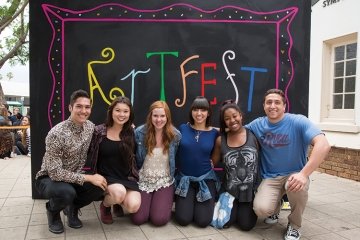
The role of CSArts–SGV’s Levine also reflects the schools’ interconnectedness.
“Four years ago, Ralph approached me about this pie-in-the-sky idea of becoming OCSA’s director of arts enrichment and program expansion,” she says.
Her role began with increasing arts outreach around Santa Ana but grew into realizing the dream of expanding to a second location where they could have a positive effect on a new community.
The Duarte campus, just blocks from the Metro Gold Line, underwent a $7.5 million renovation that included soundproofing for music rooms and new floors for dance spaces. It now has six buildings and a dozen “portable” classrooms. Performance spaces include a 500-seat theater and a 60-seat recital hall.
The current enrollment of 1,000 is expected to grow in the next school year to 1,220. CSArts–SGV draws students from more than 80 cities in the San Gabriel Valley and beyond.
Once the enrollment stabilizes, plans call for replacing portables with permanent art facilities.
In addition to its smaller size and more modest offerings, the Duarte school differs in another significant way from OCSA. Seventh- and eighth-graders take most of their academic classes at one of four nearby public schools. They then ride shuttle buses to CSArts–SGV for afternoon conservatory classes. The arrangement, Levine says, has helped to bolster the Duarte district’s numbers and funding.

Duarte had experienced declining enrollment for many years as the city’s population aged and as dissatisfied parents found slots for their children in districts with more to offer. In 2015, the district hired Allan J. Mucerino to reverse the trend. As superintendent, he and the local Board of Education agreed to partner with OCSA because it vowed to provide arts instruction for all of the district’s students, not just those who chose to attend CSArts–SGV.
Mucerino acknowledges that many proponents of traditional public schools view charters with suspicion, contending that they drain needed resources and could pave the way for a shift to vouchers for private schools—an outcome they fear could spell the demise of the vaunted system of free public education.
Charters can be “as politically polarizing as any issue in education or politics,” says Mucerino, now superintendent of the Alvord Unified School District. But, he adds, “the fact that the 15-year trend of declining enrollment has been reversed in two years is further evidence that a planned public school–charter school partnership works.”
Duarte is now the only district in the area without declining enrollment, says Gordon Amerson, who replaced Mucerino as superintendent: “That’s a direct result of the instructional program and innovative partnership.”
For Opacic, OCSA and CSArts–SGV have become the incarnation of what he had envisioned in his 1994 doctoral dissertation, “The Role of Education Foundations in Supporting Public Alternative School Programs in California.”
“We’ve created a unique, nurturing culture for students who might not otherwise be successful in a traditional public school setting,” he says. “But here they are flourishing and developing to their full potential as artists, scholars and well-rounded human beings.”
Eighth-grader Andrea Alhuay, 13, commutes from West Covina to CSArts–SGV, where she is in the integrated arts conservatory.
“To be in a place where I can share my passion for the arts is amazing,” she says. “We are all very kind to one another. I have students and teachers that are here for me. I feel I belong.”
Cohen, the trumpet-playing OCSA junior, feels much the same.
“It’s such a strong community and outlet for creative voices,” he says. “I don’t eat lunch by myself anymore.”
THE ART OF GIVING BACK
Community service is a hallmark of students at both OCSA and CSArts–SGV, especially bringing inspirational arts-education opportunities to local elementary-school-age children.
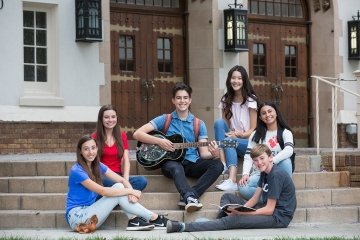
“The arts inspire happiness,” says OCSA’s Ralph Opacic EdD ’94, “so we connect our students with opportunities to share their talents with those who could use uplifting.”
► CSArts–SGV provides funding for a free dance program for all Duarte Unified K–8 schools.
► Camp OCSA is a free, 10-week after-school arts program led by juniors and seniors who teach children acting, dance, drawing, guitar, painting, singing and more.
► OCSA and CSArts–SGV partner with the Dragon Kim Foundation to provide free instrumental music instruction and instruments for children in Santa Ana and Duarte.
► Through grants from the Max H. Gluck Foundation, OCSA provides free artistic performances and programs to youth centers, schools, retirement facilities, homeless shelters, parks, health centers and more. CSArts–SGV will launch its program this year.
SPARK OF GENIUS
“The arts teach us to be human,” says Ralph Opacic EdD ’94. “They are a universal language that bridges cultures and helps us see our commonalities.”
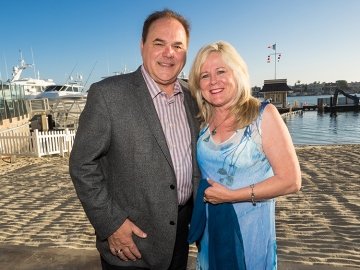
OCSA and CSArts–SGV exist because the arts-loving Opacic dreamed big. But, years before it secured its charter, OCSA began small—as an after-school choir program at Los Alamitos High School, where he was teaching English.
At the time, the high school had one choir class with 30 kids. The school allowed Opacic to add a “zero period” class, for which he recruited 60 singers in the first year. By the third year, he had five choirs with 300 kids.
Opacic applied for a grant to create an extended-day program for a school within a school; OCSA opened at Los Alamitos High in 1987 with 120 students from across Orange County. The three-year grant provided $250,000 a year, with an agreement that the program would then become self-sustaining.
While teaching full-time, Opacic earned his EdD from USC Rossier.
“My experience there strengthened my educational leadership skills, deepened my business and financial acumen, and laid the groundwork for the trailblazing work we have done in our fundraising and development efforts at OCSA and CSArts–SGV,” he says.
Even better: In class at Rossier, he met his future wife, Sherry EdD ’94, who went on to serve in the Vista Unified School District and the Orange County Department of Education.
“When people ask,” he laughs, “I like to joke that she’s the smarter, more attractive Dr. Opacic.”

